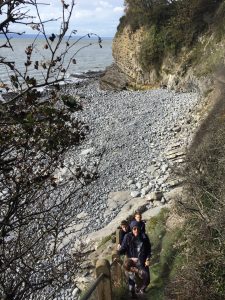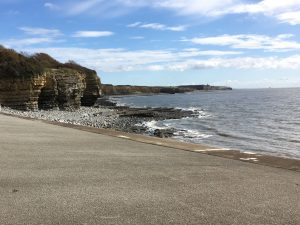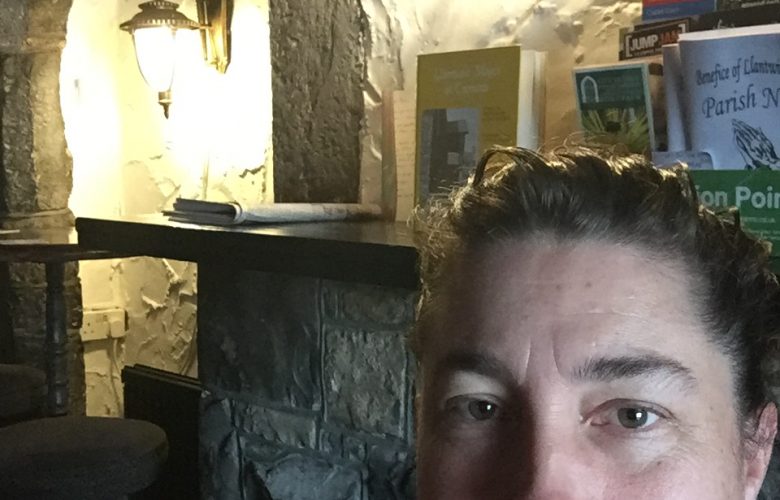South Wales blessed us with gorgeous weather for our clifftop walk along with Glamorgan Heritage coastline. We hoped that this walk would help us answer a question that, in part, promoted this trip – why did our homeland get named New South Wales? Is there any similarity between South Wales and New South Wales?
Nice and sunny, although with a fresh wind, we tramped down the farm laneway, skirting the mud, as we walked towards the coast. Less than half a kilometer later, we reached the coastal pathway, a designated walking path that traverses the edge of South Wales. The children discovered the joys of foraging for blackberries, as we followed the meandering track along towards the local surf club. This section of the walk gave us a wonderful view of the cliffs, and yes, they did remind us of the tall sandstone cliffs of Sydney Harbour. The rocks are different to home, but the shape and colour are similar.

Our debut experience of an English beach and it was everything we’d ever read about, seen on telly, and imagined. A pile of sea beaten round rocks and no surf. The tidal fall in this part of the country is ridiculous, massive at nearly 6m (second highest in the world after some place in Canada), so perhaps when the tide goes out, a beach is exposed and the surf appears. Another set of stairs up the cliff side, and we continued our coastal jaunt in the strong breeze. Along this section of the path, we encountered a couple of WWII pillboxes, and the kids enjoyed climbing inside and pretending to shoot the waves through the rifle slits.

The path then dips down to the sea again at Tresilian Bay, which is another small beach, although this one is reputed to have smugglers coves. Again, due to the high tide, we couldn’t see anything much of that nature.

The next section of walk was a bit longer, plenty of time to eat more blackberries until we saw our goal – St Donat Castle. On arrival at the cove foreshore for the castle, we discovered (and this wasn’t listed on the map, at least in any obvious way) that the castle is owned by a private school, and isn’t open to the public. You can’t even get close to it.

We had to backtrack quite a way to go around the school land, and by now the two smallest people had tired legs. They had already walked three miles (5.6km) of fairly rough terrain, including several climbs up and down the cliff, so we made the decision to walk into the village of St Donat’s (behind the school property) and take the public bus back to Llantwit Major.
The bus arrived pretty much according to the schedule (three minutes late, which is excellent for country roads and buses in general), and we bought tickets and leapt aboard. For what sounds like an ordinary occurence, this bus ride was quite special. The driver navigated narrow country laneways, beeping when he couldn’t see around the corner, then racing through, as though his beep warned anyone coming and God forbid if they didn’t listen. This driving exhibition had all the kids watching in awe, and it got better when he reached Llantwit Major. This town is ancient (many of the buildings date to before the English Civil War) and therefore the streets are made for a single horse, and perhaps a small gig at best. Certainly not for a long, unwieldy public bus. Yet the driver made it look easy as he drove these skinny winding laneways at speed, often with an inch or two on either side as he whizzed past stone walls and buildings. He’s obviously done it a billion times before, as he angled the bus just right to make several of the tight turns. Our kids, especially car crazy No3, cheered as he pulled up at our bus stop.
After our long walk (even with feeding the children snacks, sandwiches, and blackberries as we walked) we had worked up quite an appetite, so we went to the Tudor Tavern for lunch.

There are several pubs in Llantwit Major, almost too much choice for such a small town, and we chose this because it is next door to the Town Hall, a building built in the 15th century. The barkeep informed us that the Tudor Tavern is the third oldest pub in the village, but probably the oldest building of all the pubs. It used to be stables, and was converted to a pub a couple of hundred years ago. Several of the pubs used to have conjoined cellars, a hangover from the old smuggling days, and the town once held 39 pubs, a staggering figure for a town that feels as though only 39 people live there. The oldest pub, The Old Swan, is directly across the road and began business in the 16th century, and still continues to operate today. It has several English Civil War connections – presumably the same ones the Tudor Tavern had, except those patrons would leave their horses in the Tudor Tavern building.
We had an interesting chat to the barkeep about the village, and some random guy who told us about working in Brisbane. He didn’t like it because there were too many Asians, and asked if Sydney was ‘better’. We shrugged, it’s better because we embrace being part of Asia, Australia is so close to Asia, and shares many peoples and similarities that it is practically an Asian country, the kids are learning to speak Mandarin (Chinese) at school. We have many lovely Asian friends and this sort of low level racism always leaves me feeling off, however, we did try our best to stamp on it. Plus the food is amazing, I miss Sydney food and coffee. The coffee here is generally awful, so awful that the instant coffee we brew in our camping facilities is often the best coffee we have all day.
The food at the Tudor Tavern was fine, on par with everything else we’ve had so far (except Bath’s Canon), fairly simple fare that can be cooked by any staff member. Most impressive was that the barkeep was the only staff member in the pub, and he also cooked all the meals while leaving us the run of the bar. Country life is full of trust.

